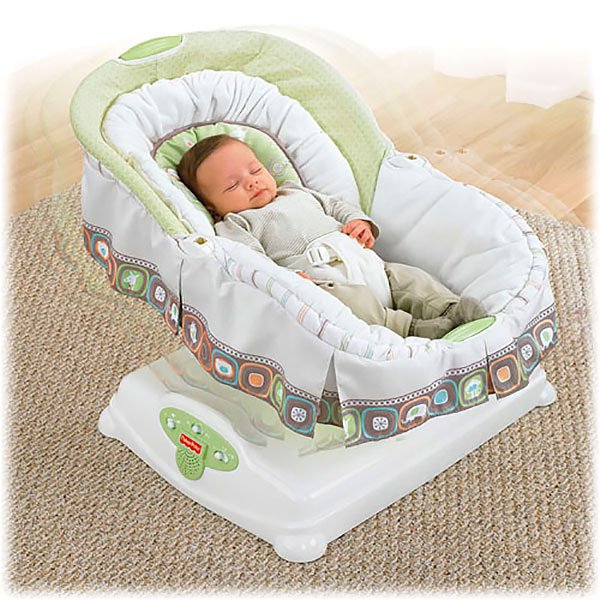Indeed, some parents are lucky - their babies fall asleep almost instantly without additional tricks. However, many babies do not want to go to sleep, and mothers have other worries besides spending a long time at the baby's cradle.
Rocking a baby is a fairly effective way of putting children into bed, known since ancient times. However, some modern scientists are convinced that this method can harm the child’s body. Is it so? And how to rock a baby correctly? Let's talk about this further.
Is it necessary to calm a child with motion sickness?
Sleep is a natural need of the human body. Night rest is especially important for children, since during their waking hours they receive a lot of new information, as a result of which their psyche can be “overloaded.”
During daytime and nighttime rest, the brain processes the information received and rests. The strength and functions of all other organs and systems are also restored. If the child does not get enough sleep, he will be lethargic, irritable and capricious.
Thus, putting the baby to sleep is the most important process that has a direct impact on child development. But the need for sleep is obvious to the mother, but newborn children may react differently to the importance of this phenomenon. Some people fall asleep instantly at night, while others are capricious, cry, and lie in bed for a long time with their eyes open.
In this case, many mothers resort to the old proven method of putting the child to sleep - motion sickness. It allows you to quickly put the newborn to bed and rest yourself. In addition, being in the mother's arms allows the baby to feel completely safe.
But how necessary is motion sickness? The question is ambiguous, because if the child calmly falls asleep without monotonous movements, then such actions on the part of the parents are not necessary. It's another matter if the baby cannot fall asleep without rocking. But even in this case, such a habit may have negative aspects.
Arguments for and against motion sickness
Doctors and psychologists have still not come to a consensus regarding the need to put newborns to sleep by rocking them in their arms. In various sources you can find information that indicates the benefits and harms of this ritual. It is important to consider the arguments on each side.
Benefit
Recently, the first 12 weeks of a child’s life are commonly called the fourth trimester of pregnancy. And this name is quite justified, since a baby who comes into this world after the usual mother’s womb needs to adapt to it.
The monotonous rocking of mother's hands or the cradle helps the child experience the same sensations that he felt while in his mother's tummy. As a result, the baby calms down on a subconscious level, feeling safe.
Experts give other arguments in favor of motion sickness:
- Rocking a baby is a traditional practice that has been used by many mothers for thousands of years. Centuries of experience have not revealed the negative impact of this method of placement on children's health.
- Rocking a child before bed means satisfying his need to be close to his mother, in physical contact. It is extremely important for a newborn baby to smell the mother’s body and milk; this develops basic trust in the world.
- Mothers, rocking their babies, help them distract from the unpleasant sensations caused by colic and teething. That is, euthanasia in this way can be called a kind of natural analgesic.
- Rocking movements help calm a cranky or overexcited child in a short period of time. This often happens if there were active games before falling asleep.
- There is an opinion that uniform motion sickness promotes the development of the children's vestibular apparatus. And this helps children quickly learn to maintain balance, crawl, and then, accordingly, walk.
- Measured movements can calm not only the child, but also the mother. And if a nursing woman is in an optimal psychological state, then feeding and other procedures will take place without much hassle.
If the father wants to rock the baby, his request must be granted. Men are less sensitive to the needs of a newborn baby than women, so rocking can help strengthen emotional bonds. And when the baby gets used to his father, the mother will be able to delegate some of her “powers” to the stronger sex.
Harm
Opponents of motion sickness present their own arguments that point to the undoubted harm of this method of putting children to sleep. First of all, researchers indicate that rocking movements prevent full sleep.
As a result, children's sleep can become restless, superficial, and intermittent. Naturally, in this case, the child will not be able to get enough sleep and rest. Why can’t you rock your baby to sleep?
- The vestibular apparatus in newborns is imperfect, so any unwanted interventions can negatively affect children's health. Children experience dizziness and even fainting, which adults mistake for sound sleep;
- If motion sickness has become a habit, then negative consequences arise. The child cannot fall asleep for a long time, sometimes you have to rock the cradle or carry him in your arms for an hour. At the same time, the baby quickly wakes up as soon as he is put into bed;
- Another negative point is that it is extremely difficult to give up motion sickness later on, since the baby refuses to fall asleep without his mother’s many hours of “shaking.” The transition to other laying methods is significantly delayed;
- The child grows up and therefore becomes heavier. If a mother pumps a bottle every evening for 60 minutes, then she faces problems with the spine and pain in her arms. The mother's overwork cannot but affect the baby's well-being.
The famous TV doctor E. Komarovsky has a negative attitude towards motion sickness in infants. He is convinced that even if such a habit does not affect children’s health, it will turn the process of falling asleep itself into a stressful situation for parents and the baby.
Many children independently outgrow the habit of falling asleep in their mother's arms by the beginning of the second year of life. However, some doctors believe that the child should be placed differently at approximately 3 to 4 months of age.
At what age should children be helped to fall asleep?
Do you remember that when your child was very young, he preferred to sleep in your arms? And as soon as I put him in his crib, he woke up right away? Years later, you may be doing the same thing—cradling your older child, scratching his back, stroking his head, or reading a book—asking yourself: Are you being too coddling?
That's why I wasn't surprised when Shelley revealed her "secret" to the group:
“I hate to admit it, but my two-year-old son still has problems falling asleep. We recently moved into a new house, and when I try to get my son to sleep in his bed, he resists, crawls out of it and cries.
Before going to bed, I always rocked him a little in my arms. My friends told me I shouldn't do it, but I saw that rocking motion helps the baby relax, so I continued. Probably, my girlfriends thought that I was simply “indulging his whims.” But I just lulled him to sleep for about five minutes until he became sleepy. Then I would put the boy in bed, stroke his back a little, and he would pass out. As a rule, after this he slept for ten hours at a time.
In a new house, with a new room and a new bed, even lulling stopped helping. The only way to help him sleep is to lie on the bed next to him. Everyone says that I need to let him cry it out and calm down on his own, otherwise I will form a bad habit in him. I do not know what to do. On the one hand, it’s not difficult for me to lie next to him so that he calms down. But, on the other hand, I’m worried that he’s already quite an old child, and still doesn’t know how to fall asleep on his own.”
Shelley understood that her son was not used to his new home, and intuitively felt that he needed physical contact with her to calm down and be ready for sleep.
Unfortunately, many books on parenting recommend the opposite approach, advising that you give your child a chance to “cry it out.” However, there is an obvious drawback to this approach. The baby is supposed to stop crying after a few minutes. Alas, hyper-emotional children do not stop crying. When their anxiety increases and gets out of control, they are unable to stop their violent reactions and calm down without help.
If your child really needs your help to relax and fall asleep peacefully; your presence and even your smell have a calming effect on him; If your baby needs you to rock him in your arms, cradle him, massage his back or stroke his head, do it! Don't feel any embarrassment or discomfort. Make it part of your bedtime routine.
Why do you have problems falling asleep?
The opinion that every child necessarily needs rocking to fall asleep is wrong. If the child is absolutely healthy, he is not teething, he is not hungry or wet, then the mother will be able to put him to bed quickly and without any problems.
And yet, it is possible to identify some circumstances that prevent you from falling asleep on your own. Dr. Komarovsky names several such factors:
- Disrupted daily routine. If parents have not developed a daily routine or taken care of discipline, then the child will fall asleep at different times. A baby who is accustomed to a certain routine falls asleep without problems.
- Little activity. A awake child must actively explore the surrounding reality. He needs to be encouraged in every possible way to move, crawl, and roll over. A slightly tired (but not overtired) baby will fall asleep quickly and sleep soundly.
- Incorrect feeding. Malfunctions in the digestive system force the baby to wake up at night. A woman needs to monitor her own diet, excluding the consumption of harmful foods. The same care must be taken when introducing complementary foods.
- Uncomfortable conditions. The inability to put a baby to sleep may be due to an uncomfortable diaper, a wet diaper, loud noises, excessively bright light or a stuffy room. It is important to follow all the rules of healthy sleep.
In addition, as we have already said, a child who is in his mother’s arms feels completely safe. The hug is a kind of reminder of those glory days when he was in his mother's belly.
Thus, one should not go to extremes - rocking the baby for several hours or even ignoring the natural children's desire to receive mother's love and affection.
Some parents, not wanting to accustom their child to motion sickness, try to hold him in their arms as little as possible. In this case, the baby will actually learn to fall asleep on his own, but delayed negative consequences are possible - low self-esteem and disruption of parent-child relationships.
How to rock a baby in your arms?
If the mother answered positively to the question whether it is possible to rock the baby to sleep, then now it is important to observe the basic conditions for proper rocking. First of all, you should not rock your baby up and down or at a very fast pace.
Failure to comply with safety precautions can end very badly: increased intracranial pressure or even rupture of brain vessels. It is necessary to rock the child slowly, smoothly, from side to side, avoiding swinging.
How to rock a baby in your arms correctly? will help answer this question :
- cradle. Take the baby in your arms, place him on your forearm, while the baby's neck should be above the elbow. Turn the baby's stomach towards you and support his butt with your other hand. Hold the baby a little closer to you and gently rock, turning left and right. The second option is to just walk around the apartment;
- back to yourself. Place your baby's stomach on your forearm so that the cheek is located in the crook of your elbow. Turn the baby's back to you, pass your other hand between your legs and press your open palm against the baby's tummy. This position is especially useful during the period of intestinal colic;
- lying down. What to do if a parent is tired of standing and walking with a child in his arms? You can rock the baby to sleep in a lying position. Place your baby's tummy on your body and then start rocking from side to side.
If the child cries even after 15 minutes of rocking, you need to check if everything is okay with him. Perhaps the baby is worried about a dirty diaper, wrinkles in the diaper, hunger, stuffiness or teething.
Rocking a baby: “FOR” and “AGAINST”
Having been in the stomach for nine months, the baby swam in the amniotic fluid, swaying smoothly to the rhythm of his mother’s steps. Therefore, according to supporters of motion sickness, this method is a natural way to calm the baby and put him to sleep. In the process of motion sickness, the vestibular apparatus of the baby is strengthened, and the work of internal organs is synchronized. Being in close contact with the mother, the baby feels comfortable and safe, which is necessary in early infancy.
Answering the question: “Is it possible to rock a child?”, opponents of this method are categorical . In their opinion, active rocking of the baby often leads to fainting, which is mistaken by parents for deep sleep. The child gets used to this way of falling asleep, and it is quite difficult to retrain him to fall asleep differently in the future (read the article: when a child sleeps only in his arms, and you start to put him in a crib, he wakes up). There is an assumption (not yet scientifically proven) that motion sickness can become a platform for the formation in the future of such harmful addictions as craving for extreme entertainment, alcoholism, and smoking.
From the first weeks of a baby’s life, young parents need to determine their position on the question: “To rock or not to rock?”, focusing on the behavior and inclinations of the baby. If your parent's instinct tells you that motion sickness can harm your baby, use other ways to put your child to sleep. If your little one is a restless, easily excitable child, perhaps gentle rocking will be the ideal way to fall asleep.
Is it possible to rock a baby to sleep (opinions)
Komarovsky's opinion:
Motion sickness using devices
If a mother is tired of rocking her baby in her arms, then you can purchase one of the many devices to carry out this process. Stores offer a wide selection of similar devices: cribs, strollers, rocking chairs and other “miracles of technology.” Let's talk about them in more detail.
Rocking center

Mom can adjust the back angle, rocking mode, and music that will entertain the small child. Additionally, the child is secured using safety straps.
Why is such a product needed? With its help, parents will be able to take a break from motion sickness and spend a few minutes on household chores or personal matters. It is only important to choose a device suitable for newborn babies.
The center has many advantages. The only disadvantage of such a rocking device is its high cost.
Chaise lounge chair
This device is not as expensive as a motion sickness center. However, its functionality is somewhat limited. The lounge chair is equipped with vibration, music and hanging toys.
This product is usually used from birth to 9 months of age. To make it comfortable for the newborn to lie down, a special anatomical insert is placed in the chaise lounge.
These chairs are very mobile. Parents note that the device can be folded and taken with you on a long journey. However, among the disadvantages one can highlight a short service life.
Swing chair
Such devices are also called rockers. They work thanks to rounded metal runners on which the baby cradle is installed. The swing is set in motion by the baby's movements or the efforts of an adult.
You can block the movements of the swing using special legs located in front and behind. Such devices are equipped with various functions: vibration, arc toys, music, light effects.
Car seat category “0+”
You can rock a newborn to sleep using a car carrier, although this holding device is intended primarily for transporting babies in a car.
High-quality baby carrier models have a rocking function due to the rounded base.
That is why many mothers adapt such devices for rocking their baby, although they will have to make some effort.
In general, it is enough for a mother to simply rock the chair with one hand, and at the same time she can read a book, listen to her favorite music or enjoy a tasty drink.
Stroller
Despite the fact that not all experts have a positive attitude towards the idea of rocking a child to sleep in strollers, babies usually fall asleep very well in these vehicles.
Fresh air and gentle movement help you sleep quickly and soundly. It makes no sense to talk in detail about this device, but it is important to clarify that not all strollers have a motion sickness function. It is worth choosing bassinets designed specifically for newborns.
Sling
A fabric baby carrier is an excellent option for rocking a baby to sleep without interrupting important work. This device provides uniform support for all parts of the spinal column and the child’s head, involves close contact between the baby and the mother, and also frees up the hands.
The only drawback is that the mother needs to get used to wearing a sling and the weight of a baby. In addition, it is necessary to choose the optimal device for a newborn baby, since not all headbands are suitable for the smallest children.
Ergo backpack
Another version of a sling, only it resembles a backpack rather than a bandage. This device is used for carrying and rocking babies who can already hold their head and sit quite confidently.
The baby sits behind the mother's back or faces her, which is also useful for forming strong parent-child relationships. The process of motion sickness itself occurs due to the uniform movement of the parent with this same backpack.
Fitball
A large inflatable ball is a great helper for the whole family, as it allows you to do fitness, do exercises with your baby and rock the little person to sleep.
There are 2 main ways to rock a child on an inflatable ball:
- The mother sits on the ball, takes the child in her arms, and slowly jumps on the fitball.
- A small blanket or diaper is placed on the ball, and only then the child is placed on the device. The fitball is smoothly swung from side to side.
Choose your fitball very carefully. To prevent motion sickness from causing any inconvenience to you and your child, you need to choose a device taking into account your height.
Hammock
Hanging net is a great outdoor accessory. However, some mothers successfully use a hammock to rock their baby to sleep. Naturally, one child cannot be placed on it. First, the mother lies down in the net, and only then puts the baby on top of her.
To avoid injury, you need to pay attention to the fastening of the suspension device. Also, we must not forget about the soft mat, which is placed directly under the hammock.
Folk remedies for motion sickness of a child in transport

If you are still wary of the side effects of pills, then you should give preference to traditional methods. But remember that they may not be as effective as medications. If folk remedies do not help, then it is better to return to drugs from traditional medicine. Here are folk remedies that ease the condition of the body on the road:
- Mint, chamomile . You can take a mint leaf with you on the road and give it to your child to hold in his hand and smell. But, if the child is small, he may pull the leaf into his mouth, so it is better to use essential oils in this case. A few drops on a handkerchief or napkin will be enough to reduce the symptoms of motion sickness.
- Ginger . A piece of this root can be chewed on the road. If it seems tasteless to your child, then before the trip you should brew ginger root and give the child something to drink: 1 teaspoon of ground ginger per 1 glass of boiling water. Leave until it cools completely and give it to your child after meals.
- An infusion of unrefined oat grains . Pour 200 ml of boiling water over one tablespoon of oats, leave until completely cool, strain and give to the child. Don’t force him to drink a whole glass of infusion, let him drink as much as he can and wants - that will be enough. You can drink the infusion 2-3 days before the trip - 2 tablespoons 2 times a day.
- You need to drink in small sips on the road . If your baby drinks a lot of water in one gulp, he may vomit.
- Talk to your child about topics that are interesting to him . This will help you get distracted and the brain will “forget” about unpleasant symptoms.
- Do not feed your baby tightly before traveling . But you don’t need to starve either. It is enough to eat 100 grams of cottage cheese, yogurt or a little porridge, but not very sweet.
If you stop on the road for a snack, then wait 15 minutes until your body adjusts to a different environment. You can just walk or sit in the cool.











